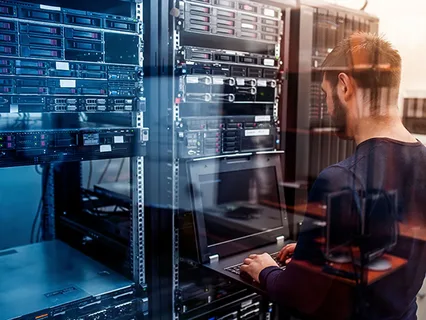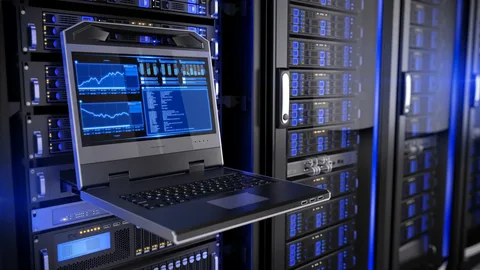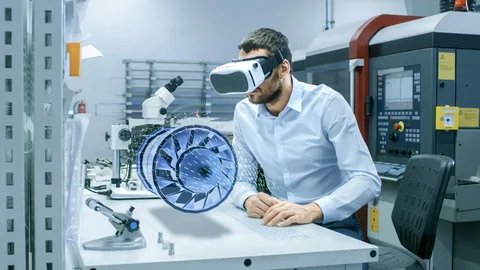Introduction
Welcome, everyone, to the Advanced Hardware Lab 7-5, where we delve into the intricate realm of network technologies. In today’s digital age, where connectivity is the lifeblood of communication, understanding the intricacies of network technologies is paramount. This lab serves as a gateway to unraveling the complex web of wired and wireless connections that seamlessly link devices, enabling the global exchange of information.
As we embark on this exploration, we’ll navigate through the backbone of modern communication systems. From the familiar Ethernet technologies that form the bedrock of local networks to the ethereal world of wireless connectivity, we’ll dissect the technologies that power our interconnected world. Along the way, we’ll shine a light on the invisible highways of data transmission – the fiber optic networks that propel information at the speed of light.

But it’s not just about the hardware; we’ll also decipher the language of the digital world through protocols like TCP/IP and UDP, uncovering the protocols that enable devices to communicate harmoniously. As we uncover the layers of network technologies, we’ll also touch on the vital aspect of security – exploring the technologies that safeguard our networks from cyber threats.
In this lab, we won’t merely scratch the surface; we’ll delve into emerging technologies that are shaping the future landscape of networking. By the end of our journey, you’ll not only identify various network technologies but also appreciate their profound impact on the way we connect, communicate, and collaborate in the digital age.
So, fasten your seatbelts as we embark on a journey through the arteries of the digital realm, where every bit and byte pave the way for seamless connectivity. Let’s dive into Advanced Hardware Lab 7-5 and unravel the fascinating world of network technologies.
Table of Contents
Navigating the Complex Web of Network Technologies
Welcome to the immersive experience of Advanced Hardware Lab 7-5, where we embark on a journey to unravel the intricate world of network technologies. In this digital era, connectivity is not just a convenience; it’s the lifeline that fuels global communication and collaboration. In this lab, we will dissect and explore the fundamental and advanced aspects of network technologies that form the backbone of our interconnected world.
Understanding the Landscape of Network Technologies
In the digital landscape, network technologies are the unsung heroes that enable the seamless flow of information between devices. From the local networks that power our everyday connectivity to the global infrastructure that underpins the internet, the intricacies of these technologies are vast and varied.
Overview of Network Technologies
1. Ethernet Technology: Connecting Locally
Ethernet Fundamentals: At the heart of local area networks (LANs) lies Ethernet technology.Advanced hardware lab Developed in the 1970s, Ethernet has evolved into a ubiquitous standard for wired connections. Its various iterations, such as 10/100/1000 Mbps, cater to different bandwidth needs. Understanding the nuances of Ethernet is crucial for comprehending the foundations of network connectivity.
Applications of Ethernet: Ethernet isn’t merely Advanced hardware lab a cable connecting your computer to a router; it’s the backbone of local communication within homes, offices, and data centers. Whether you’re streaming content, engaging in video conferences, Advanced hardware lab or transferring files, Ethernet plays a pivotal role in ensuring reliable and high-speed data transfer.
2. Wireless Technologies: Liberating Connectivity
Wi-Fi Standards: The wireless frontier is dominated by Wi-Fi technologies, characterized by standards like 802.11a/b/g/n/ac. Each standard brings improvements in speed, range, and efficiency. Understanding these standards is essential for navigating the wireless landscape and optimizing connectivity.
Advantages and Challenges of Wireless Networks: While wireless networks offer unparalleled flexibility, they come with their set of challenges. Interference, security concerns, and varying speeds are aspects that need careful consideration. Exploring the advantages and challenges of wireless technologies equips us to make informed decisions in setting up and managing wireless networks.
3. Fiber Optic Technology: Riding the Lightwaves
Fundamentals of Fiber Optics: In the pursuit of high-speed data transmission, fiber optic technology takes center stage. Unlike traditional copper cables Advanced hardware lab , fiber optics leverage light signals to transmit data at incredible speeds. Delving into the fundamentals of fiber optics unveils the science behind this revolutionary technology.
Benefits of Fiber Optics: The benefits Advanced hardware lab of fiber optics extend beyond speed. With greater bandwidth and resistance to electromagnetic interference, fiber optics are the backbone of long-distance communication, powering internet backbones and global networks. Understanding these benefits provides insights into the strategic deployment of fiber optic infrastructure Advanced hardware lab.
Networking Protocols: The Language of Digital Communication
4. Networking Protocols: Enabling Seamless Communication
TCP/IP, UDP, and HTTP: Building Blocks of Communication: At the heart of digital communication are protocols like TCP/IP, UDP, and HTTP. These protocols govern how data is transmitted and received across networks. Exploring their functions and interactions unravels the Advanced hardware lab complex language that devices use to communicate effectively.
Facilitating Communication: TCP/IP, in particular, is the bedrock of the internet. Understanding how it breaks down data into packets, routes them across networks, and reassembles them at their destination is fundamental to comprehending the intricacies of digital communication. Similarly, UDP and HTTP play crucial roles in specific applications, showcasing the diversity of protocols.

Network Topologies: Understanding the Architecture of Connectivity
5. Network Topologies: Architecting Connectivity
Different Network Topologies: Networks come in various shapes and forms, known as topologies. Whether it’s the simplicity of a bus topology or the redundancy of a mesh topology, each architecture serves a specific purpose. Understanding these topologies Advanced hardware lab provides insights into how networks are structured and how data flows within them.
Advantages and Disadvantages: No topology is one-size-fits-all. Each comes with its own set of advantages and disadvantages. For instance, a star topology offers centralized control but may suffer from a single point of failure. Exploring these nuances empowers Advanced hardware lab network architects to design systems tailored to specific needs.
Network Security Technologies: Safeguarding the Digital Realm
6. Network Security Technologies: Defending Against Cyber Threats
Firewalls, Encryption, and Intrusion Detection: The Guardians of Networks: As our reliance on digital connectivity grows, so does the need for robust security measures. Firewalls act as gatekeepers, filtering incoming and outgoing traffic. Encryption secures data during transmission, and intrusion detection systems monitor for suspicious activities. Understanding these technologies is Advanced hardware lab essential for maintaining the integrity of networks Advanced hardware lab.
The Importance of Network Security: In an era where cyber threats are omnipresent, the importance of network security cannot be overstated. Whether it’s protecting sensitive information or ensuring the availability of services, network security technologies form the frontline defense against a myriad of cyber threats.
Emerging Technologies: Paving the Way for the Future
7. Emerging Technologies: Shaping the Future of Connectivity
Recent Advancements: The world of network technologies is dynamic, with continuous advancements shaping the future. From the integration of artificial intelligence in network management to the rise of 5G technology, staying abreast of these developments is crucial for professionals in the field.
Potential Impacts on Networking: Exploring emerging technologies allows us to anticipate their potential impacts on networking infrastructure.Advanced hardware lab For instance, the widespread adoption of 5G promises unprecedented speeds and low latency, revolutionizing how we experience connectivity. Examining these trends provides a glimpse into the future landscape of network technologies Advanced hardware lab.
Hands-On Demonstration: Bridging Theory and Practice
8. Hands-On Demonstration: Applying Knowledge in Practice
Practical Exploration: Theory comes to life through hands-on exploration. A practical demonstration allows participants to apply their knowledge, identify network technologies in action, and troubleshoot common issues. This immersive experience enhances comprehension and reinforces the practical skills needed in real-world scenario Advanced hardware labs.
Simulation and Interaction: Whether it’s configuring routers, analyzing network traffic, or setting up secure connections, simulations offer a risk-free environment for participants to experiment and learn. The interactive nature of hands-on activities fosters a deeper understanding of the concepts covered in the lab.
Q&A Session: Addressing Curiosities and Clarifications
9. Q&A Session: Fostering Understanding Through Interaction
Open Dialogue: A Q&A session serves as a platform for participants to seek clarification, delve deeper into specific topics, and share insights. Open dialogue fosters a collaborative learning environment and allows participants to gain a nuanced understanding of network technologies.
Addressing Concerns: Every question is an opportunity to address concerns and enhance overall comprehension. Encouraging participants to voice their queries ensures that everyone leaves the lab with a solid grasp of the covered material.
Conclusion: Unveiling the Fascinating World of Network Technologies
10. Conclusion: Summarizing the Journey
As we conclude our exploration of Advanced Hardware Lab 7-5, we’ve traversed the vast landscape of network technologies. From the foundational elements of Ethernet and wireless connectivity to the futuristic realms of emerging technologies, our journey has been both comprehensive and enlightening.
Appreciating the Diversity of Networks: Network technologies are not one-dimensional; they are a tapestry of interconnected components that facilitate communication on various scales. Each technology, protocol, and security measure contributes to the seamless functioning of networks.
Relevance in the Digital Age: In a world where connectivity is synonymous with progress, the knowledge gained in this lab is not just theoretical; it’s a toolkit for navigating the complexities of the digital age. Whether you’re a budding network engineer or a technology enthusiast, the insights gained here have real-world applications.
Continued Learning: The field of network technologies is ever-evolving. As technologies advance and new challenges emerge, the quest for understanding remains ongoing. Embracing a mindset of continued learning ensures that we stay at the forefront of this dynamic field.
As we bid farewell to Advanced Hardware Lab 7-5, remember that the journey doesn’t end here; it’s a stepping stone into the fascinating and ever-expanding world of network technologies.

FAQs -(Advanced hardware lab)
1. What is the primary focus of Advanced Hardware Lab 7-5?
- Advanced Hardware Lab 7-5 focuses on the identification and understanding of various network technologies. Participants will explore the fundamentals of wired and wireless connectivity, networking protocols, security technologies, and emerging trends in the field.
2. Why is it important to study network technologies?
- Studying network technologies is crucial in today’s interconnected world. It enables individuals to comprehend the infrastructure that facilitates communication between devices, ensuring a solid foundation for those pursuing careers in networking, IT, and related fields.
3. Can you provide more details on Ethernet technology and its applications?
- Certainly. Ethernet is a widely used technology for local area networks (LANs). It involves the use of cables to connect devices within a limited geographical area. Its applications range from everyday internet usage to facilitating communication within offices, homes, and data centers.
4. How do wireless technologies, such as Wi-Fi, function in network connectivity?
- Wireless technologies, like Wi-Fi, enable devices to connect without physical cables. Wi-Fi standards, such as 802.11a/b/g/n/ac, define the rules for wireless communication. Devices communicate by sending and receiving radio signals, allowing for flexible and mobile connectivity.
5. What sets fiber optic technology apart, and why is it important?
- Fiber optic technology uses light signals to transmit data, offering significantly higher speeds and bandwidth compared to traditional copper cables. Its resistance to electromagnetic interference makes it essential for long-distance communication, forming the backbone of global networks.
6. Can you explain the role of networking protocols like TCP/IP and UDP?
- Networking protocols, such as TCP/IP and UDP, govern how data is transmitted and received across networks. TCP/IP, the foundation of the internet, ensures reliable communication by breaking data into packets. UDP, on the other hand, is used for faster but less reliable communication. Understanding these protocols is key to effective data exchange.
7. How do different network topologies impact connectivity?
- Network topologies, such as bus, star, ring, and mesh, define how devices are interconnected. Each topology has its advantages and disadvantages. For example, a star topology offers centralized control, while a mesh topology provides redundancy. The choice of topology depends on specific networking needs.
8. Why is network security important, and what technologies are involved?
- Network security is crucial to protect sensitive data and ensure the integrity of networks. Technologies like firewalls filter network traffic, encryption secures data during transmission, and intrusion detection systems monitor for suspicious activities. These measures collectively safeguard networks from cyber threats.
9. How do hands-on demonstrations enhance the learning experience?
- Hands-on demonstrations provide a practical application of theoretical knowledge. Participants can engage in activities like configuring routers, analyzing network traffic, and setting up secure connections. This interactive approach reinforces understanding and prepares individuals for real-world scenarios.
10. What are some emerging technologies discussed in the lab, and how might they impact networking?
- The lab explores emerging technologies, including advancements in artificial intelligence in network management and the rise of 5G technology. These innovations have the potential to revolutionize network speed, efficiency, and connectivity, shaping the future landscape of networking.
11. Is the knowledge gained in this lab applicable in real-world scenarios?
- Absolutely. The knowledge gained in this lab is directly applicable in real-world scenarios. Whether you’re a network engineer, IT professional, or technology enthusiast, understanding network technologies is essential for effectively navigating and managing the complexities of modern digital communication.
12. How can participants continue learning about network technologies beyond the lab?
- The field of network technologies is dynamic and continually evolving. Participants can stay informed by following industry updates, engaging in online courses, participating in forums, and exploring advanced certifications. Embracing a mindset of continuous learning ensures that individuals remain at the forefront of this ever-changing field.
 Nextezone: Igniting Tomorrow's Potential with Innovation Today Innovate. Explore. Elevate. Nextezone – Where Vision Meets Innovation.
Nextezone: Igniting Tomorrow's Potential with Innovation Today Innovate. Explore. Elevate. Nextezone – Where Vision Meets Innovation.
